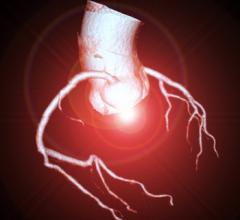
A CT calcium scoring image showing calcified plaques in coronary vessel segments. The higher the calcium content of the vessels, the higher risk the patient is for a heart attack event. Image courtesy of Canon Medical Systems.
A picture is worth a thousand words, and to patients concerned about their health, detailed images of the coronary anatomy can push many of them over the edge to make serious lifestyle changes or agree to start statin therapy. Computed tomography (CT) offers detailed anatomical imaging of the coronaries and low-dose CT calcium scoring scans (CAC) can offer great heart attack risk assessment tools in asymptomatic patients.
"The only way the coronary arteries get calcified is when you have a microscopic plaque that ruptures and the calcium is used by the body to wall off the plaque from the rest of the artery so you don't get a microvascular rupture, which is a heart attack or stroke. So calcification is essentially scar tissue, but the only people who get that scar tissue are those who have had plaque ruptures," explained Matthew Budoff, M.D., FACC, professor of medicine, David Geffen School of Medicine at UCLA, endowed chair of preventive cardiology, Harbor-UCLA Medical Center. He is an expert in CT calcium scoring and has been involved in several of the trials.
In asymptomatic, middle age patients, he said conventional cardiac risk calculators are not that great at assessing intermediate risk patients.
"Doctors have a real dilemma sometimes," Budoff said. "We have the Framingham Risk Score, but sometimes patients come out in the middle, in the gray zone, and we really don't know if they are high risk and should have statins and aspirin for the rest of their life, or if they can be managed through diet and exercise. Half will go on to have a heart attack and half will not. The risk calculators we have now are only correct about 60 percent of the time. So instead of using a coin to decide if patients should get statins and aspirin, we used personalized medicine to look at each individuals's heart. We have found that calcium scoring is the best way to assess their risk."
Watch the VIDEO: New Cholesterol Guidelines Support CT Calcium Scoring for Risk Assessment, an interview with Budoff on the new 2018 ACC/AHA cholesterol guidelines that now include recommendations to use CT calcium scoring.
Mounting Evidence for Calcium Scoring
Budoff noted calcium scoring is now included in the guidelines to assess patients based of mounting evidence from several big clinical trials.
"We now have a lot of large scale clinical data to support this — the PROMISE Trial, the Multi-Ethnic Study of Atherosclerosis (MESA), the Rotterdam Study, the Dallas Heart Study, and many other trials that all show basically the same thing.[1-6] A high calcium score is high risk, and a zero calcium score is low risk. Based on this you can up titrate patients' medical therapies based on a high-risk patient. But, maybe more importantly, we can use what we call the power of zero to justify using less therapies in people with no calcium who are low risk," Budoff explained.
The most recent of these was the PROMISE, presented as a late-breaking study at the European Society of Cardiology (ESC) 2017. Budoff said 10,000 patients were randomized 1:1 to CT angiography (CTA) for anatomical testing, or functional testing using a nuclear scan. They looked at 4,200 patients who had a CT calcium score verses function stress testing. "Basically what it showed was that CT calcium scoring predicted events just as well as functional testing and at a much lower cost and it was easier to use," Budoff explained.
Other clinical trials continue to show the prognostic value of CAC.[7-10]
CT Scans Can Convince Patients to Take Statins
Patients often raise concerns about taking statins because it is a daily medication they need to take for the rest of their lives, and because of the low possibility of liver or muscle damage and cognitive changes from the drug, he said.
"I make a deal with my patients in advance, I tell them they should get a calcium score scan, it might cost them $150, and if they are clean, I am not going to bug them for five years," Budoff said. "If on the other hand we find significant plaque, I am going to have them start statins and aspirin."
The cost of CT calcium scoring exams is often much less, around $50 at many hospitals that use the lower prices to attract patients for screenings. The return on investment for hospitals is when high-risk patients are identified and then stay within that hospital system for both prevention services and any future cardiac events.
CT Will Play an Increasing Role in Tracking Coronary Health
"What people need to understanding is that no other modality will identify early coronary disease," said Leslee Shaw, Ph.D., professor of cardiology and radiology, Weill Cornell Medical Center, New York, and past-president of the Society of Cardiovascular Computed Tomography (SCCT). "Stress testing does not pick it up until there is enough disease to produce ischemia. The heart of CT is its ability to improve earlier detection of coronary plaque, that can really put a patient on a different course of prevention. CT has the promise to identify these patients earlier."
Shaw explained pictures of a patients heart and coronary vessels are very convincing when a doctor tries to explain to a patient their risk of having a heart attack and why they need to change their lives and take statins. She said coronary CT will play an increasing roll in the coming years as a risk assessment screening tool, mainly for its ability to show coronary plaque burden before any other noninvasive modalities. Calcium scoring also adds a solid risk assessment for future events.
As CT doses continue to decline to the range of 1 mSv or below, Shaw explained that serial CT scans will likely be used every few years to assess patients' disease levels. Shaw said these images can be used to clearly document any reversal in disease due to diet, exercise and statin use. She said this might be a better way to literally show patients the impact on their health based on their own lifestyle choices of diet and exercise, and the use of statins. Currently, patients are asked to blindly change their diet, told to exercise and begin taking life-long medications without having any idea of what their disease level really is or if what they are doing has any impact on their health. Shaw said serial CT scans can offer a baseline much more accurate to track cardiovascular health over time and be an incentive for patients to not only make healthy choices, but also determine whether they should start or continue statin therapy.
A Texas bill enacted a few years ago allows for CT calcium scoring to be done every five years. “We are now seeing high rates of growth in CT usage there,” Shaw said, adding this will likely be the model for the future.
Related CT Calcium Scoring Content:
VIDEO: CT Calcium Scoring to Screen For Who Should Take Statins — Interview with Matthew Budoff, M.D.
VIDEO: The Future of Cardiac CT in the Next Decade — Interview with Leslee Shaw, Ph.D.
VIDEO: Latest Trials on Cardiac CT Compared to Functional Testing — Interview with Matthew Budoff, M.D.
VIDEO: Role of Cardiac CT in Value-based Medicine — Interview with Leslee Shaw, Ph.D.
Link to the Multi-Ethnic Study of Atherosclerosis (MESA) CAC Risk Score Calculator
VIDEO: New Cholesterol Guidelines Support CT Calcium Scoring for Risk Assessment — Interview with Matthew Budoff, M.D.
ACC and AHA Release Updated Cholesterol Guidelines for 2018
VIDEO: The History of CT Calcium Scoring — Interview with Arthur Agatston, M.D.
References:
6. Paixao AR, Berry JD, Neeland IJ, et al. Coronary artery calcification and family history of myocardial infarction in the Dallas heart study.
JACC Cardiovasc Imaging. 2014 Jul;7(7):679-86. doi: 10.1016/j.jcmg.2014.04.004. Epub 2014 Jun 18.


 December 11, 2025
December 11, 2025 









